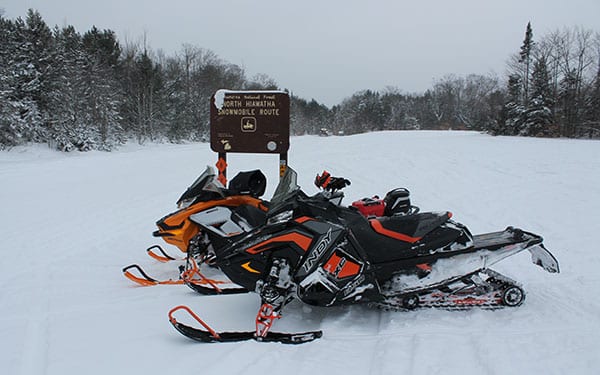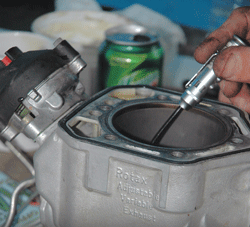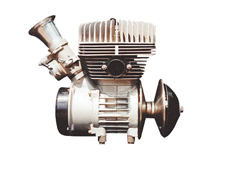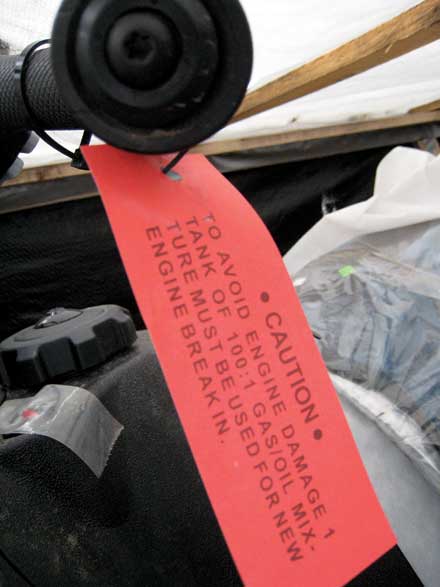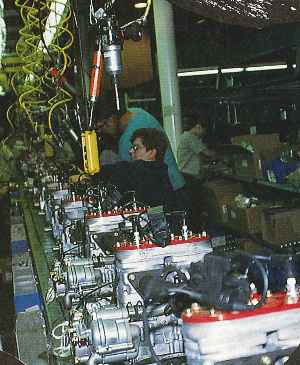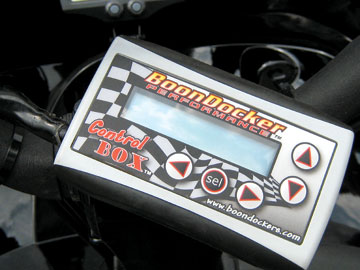The machine is serial number 190 of 229 of the first Ski-Doos that were mass produced. The graceful, 5-foot long birch skis and the incredibly simple, utilitarian design of the device are impressive.
What is really missing on that old Ski-Doo is the application of electricity. The Kohler K-161P, four-stroke engine produced 7 hp at 3600 rpm. The engine’s magneto produced enough electricity to spark the plug but had no lighting coils in it to supply electricity for any other purpose. Light would have been nice.
Joseph-Armand Bombardier was always a practical and logical guy who simply went outside the lighting problem and bought some bicycle lighting systems that included a generator, head and taillight. He developed a rubber friction drive wheel that would mount on the generator that could be engaged against the governor bell of the drive pulley on the engine when light was needed.
The bicycle headlight mounted on the hood and the tiny taillight mounted at the upper left corner of the hood. The system operated at 6 volts and the headlight offered a stunning, 3-watt bulb while the taillight was 1 watt. The lighting system was probably more effective at letting others know you were in the area at night than lighting the path for the operator, although the exhaust note would have done any alerting before the light was seen.
Beginning at about 4 watts at 6 volts, electrical systems on snowmobiles have grown to 65 amps at 13.5 volts (877 watts). If you want to convert some of the figures used in this article remember the pie rule, P=IE, where:
P=Electric power measured in watts (w)
I=Intensity (current) measured in amperes (a)
E=Electromotive force measured in volts (v)
Any machine equipped with a battery that must be charged on-board the snowmobile will regulate the electrical output of the magneto/alternator to 13.5 to 14 volts. The voltage must be slightly higher than that of the battery to be able to charge the battery.
The magnetos on most snowmobile engines mount charging coils to power the ignition systems, and lighting coils to power all other electrical devices. But this is beginning to change.
There are many variations of magneto designs, but the one thing that has continued to change in design is the power output of the lighting coils, or total power of the magnetos/alternators. Lighting coil output hovered between 40 and 75 watts through the 1960s, and the almost continuous growth in electrical power output started in the early 1970s.
The first massive leaps in electrical power output came with the introduction of Arctic Cat’s four-stroke 660 in 2002. Because the three-cylinder Suzuki engine is also applied to a microcar, the entire electrical system is automotive, including a belt driven alternator. The alternator on the 660 is the largest in the snowmobile business, putting out 65 amps at 13.5 volts.
Other four-stroke snowmobile engines sporting automotive-type alternators are Polaris’ new 750cc FS and FST engines that drive 50 amp alternators, and Ski-Doo’s V-1000 which uses a 40 amp alternator. The use of an automotive alternator is an inexpensive solution to supply a lot of electrical power that certainly allows for a lot of new electrical accessories.
Conventional snowmobile magnetos have been growing in output, too. The new Yamaha four-cylinder four-strokes pack 35 amps at 14 volts. Ski-Doos engines run with magneto output of 290 watts to 480 watts depending upon the accessories and engine management systems on the particular sled. Arctic Cat’s lay-down two-stroke engines run 235-watt lighting coils.
The output of these alternators varies with engine speed. These quoted outputs are measured at about 8000 rpm. Output at 3500 rpm will generally drop by about 20 percent.
The output of any alternator is, of course, alternating current. Direct current is required to charge a battery. In the past, only a portion of the output of the magnetos or alternators was rectified for charging the battery. Lighting systems were generally left on AC to keep their drain off the battery. As engine management systems have become more complex, it is becoming more common to rectify all the output and run all electrical systems on DC.
Riders who want to add an electrical device to their machines need to know how its electrical system is laid out and take care not to link any AC circuits with DC circuits. This is often done, unwittingly, when connecting grounds to the chassis while adding accessories.
The ever-growing electrical demands on snowmobiles has been driven by the need to meet emissions standards. Electronic fuel injection and ever-increasing computing power is necessary to drive the engine management systems. The application of micro-car engines brought with them alternators that can more than handle the current needs of snowmobiles.
Because that electrical energy is there, we’re beginning to see some pretty neat electrical accessories. Just a few years ago you couldn’t have even thought of having enough current to effectively heat a seat. Arctic Cat has introduced this feature on its four-strokes because they can. Arctic Cat has also introduced its Cat Comm on their four-stroke touring sleds — again, because the sled has an electrical system strong enough to power it.
Arctic’s Crosstec VRE helmet also taps into the available power with an electrically heated shield and is fitted with speakers and a microphone to function with the Cat Comm. We wouldn’t be a bit surprised to see navigational systems show up on sleds along with electronic control of new transmission systems.
This electrical energy isn’t free, however. It has to be generated and that takes power from the engine. One horsepower is equal to 746 watts of electrical energy, but you don’t get 746 watts of electrical power from one horsepower drawn from the crankshaft. Alternators don’t function at 100 percent efficiency and the belt drive systems that power them suck up additional power. The other factor is the weight these systems add to the machine.
There will certainly be more and more electrical options added to snowmobiles. All brands run at least two headlights at 55 to 60 watts each. Compare that to that first Ski-Doo at 3 watts at 6 volts. Every manufacturer has provided some space in their electrical systems for options, usually 30 watts or more.
It is important to remember that the engine management system on contemporary sleds is controlled by electricity. If the system becomes overloaded with accessories voltage will begin to drop. A voltage drop in the system will affect the control of the system that operates an engine.
There are several new and wonderful electrical options to wire into a snowmobile’s modern day electrical system. Just make sure the capabilities of the machine have the juice to back it up.

